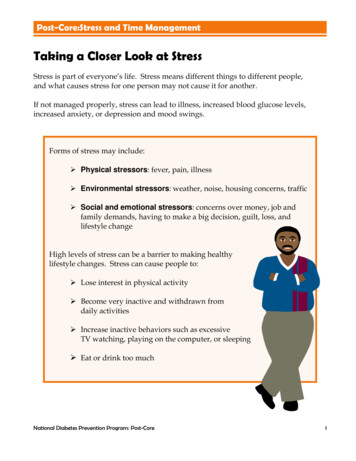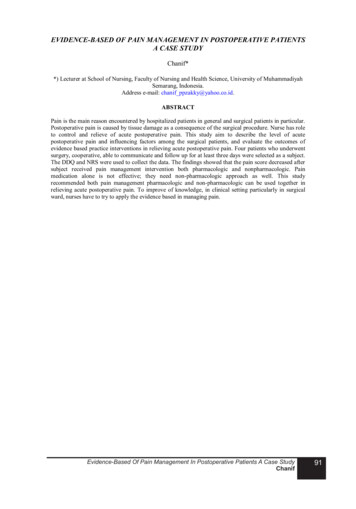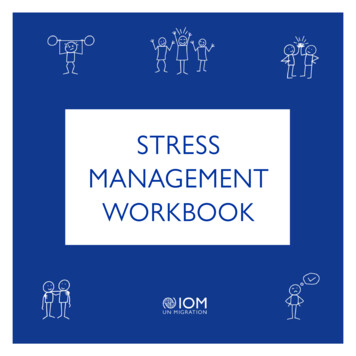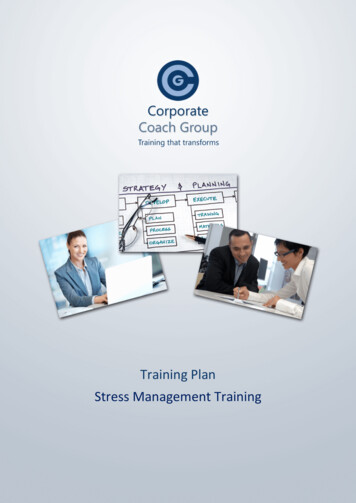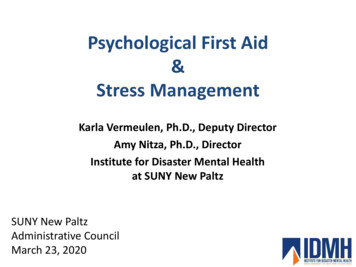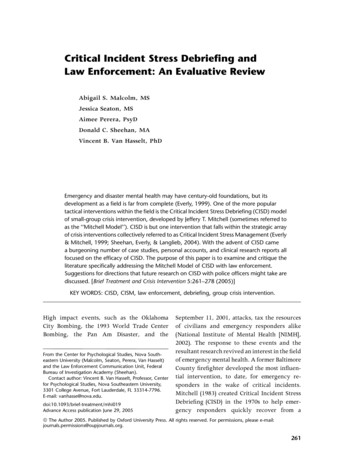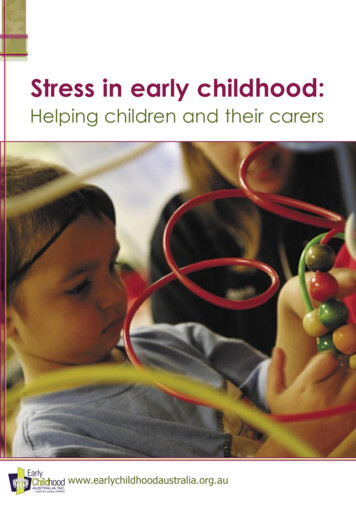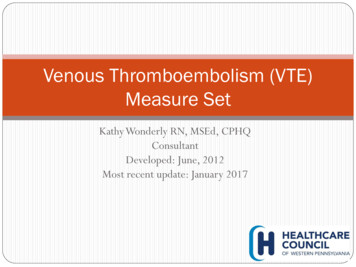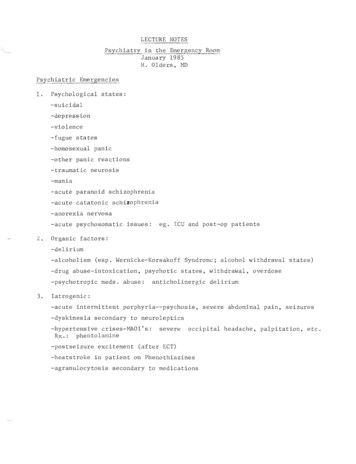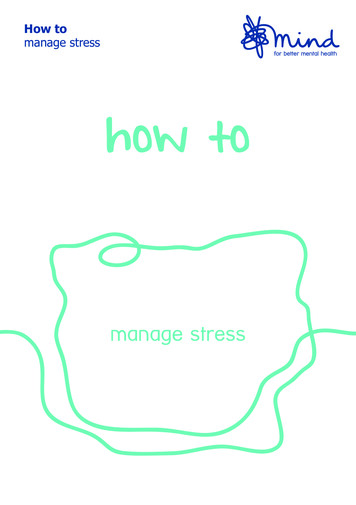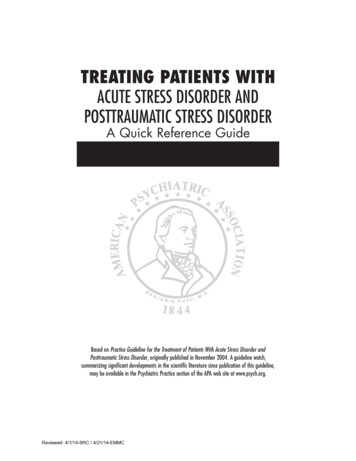
Transcription
TREATING PATIENTS WITHACUTE STRESS DISORDER ANDPOSTTRAUMATIC STRESS DISORDERA Quick Reference GuideBased on Practice Guideline for the Treatment of Patients With Acute Stress Disorder andPosttraumatic Stress Disorder, originally published in November 2004. A guideline watch,summarizing significant developments in the scientific literature since publication of this guideline,may be available in the Psychiatric Practice section of the APA web site at www.psych.org.Reviewed: 4/1/14-SRC / 4/21/14-EMMC
American Psychiatric AssociationSteering Committee on Practice GuidelinesJohn S. McIntyre, M.D., ChairSara C. Charles, M.D., Vice-ChairDaniel J. Anzia, M.D.Ian A. Cook, M.D.Molly T. Finnerty, M.D.Bradley R. Johnson, M.D.James E. Nininger, M.D.Paul Summergrad, M.D.Sherwyn M. Woods, M.D., Ph.D.Joel Yager, M.D.Area and Component LiaisonsRobert Pyles, M.D. (Area I)C. Deborah Cross, M.D. (Area II)Roger Peele, M.D. (Area III)Daniel J. Anzia, M.D. (Area IV)John P. D. Shemo, M.D. (Area V)Lawrence Lurie, M.D. (Area VI)R. Dale Walker, M.D. (Area VII)Mary Ann Barnovitz, M.D.Sheila Hafter Gray, M.D.Sunil Saxena, M.D.Tina Tonnu, M.D.Medical Editors, Quick Reference GuidesMichael B. First, M.D.Laura J. Fochtmann, M.D.StaffRobert Kunkle, M.A., Senior Program ManagerAmy B. Albert, B.A., Assistant Project ManagerClaudia Hart, Director, Department of Quality Improvementand Psychiatric ServicesDarrel A. Regier, M.D., M.P.H., Director, Division of ResearchReviewed: 4/1/14-SRC / 4/21/14-EMMC
Statement of IntentThe Practice Guidelines and the Quick Reference Guides are not intended to beconstrued or to serve as a standard of medical care. Standards of medical care aredetermined on the basis of all clinical data available for an individual patient andare subject to change as scientific knowledge and technology advance and practicepatterns evolve. These parameters of practice should be considered guidelines only.Adherence to them will not ensure a successful outcome for every individual, norshould they be interpreted as including all proper methods of care or excludingother acceptable methods of care aimed at the same results. The ultimate judgment regarding a particular clinical procedure or treatment plan must be made bythe psychiatrist in light of the clinical data presented by the patient and the diagnostic and treatment options available.The development of the APA Practice Guidelines and Quick Reference Guideshas not been financially supported by any commercial organization. For moredetail, see APA’s “Practice Guideline Development Process,” available as an appendix to the compendium of APA practice guidelines, published by APPI, and onlineat http://www.psych.org/psych pract/treatg/pg/prac guide.cfm.Reviewed: 4/1/14-SRC / 4/21/14-EMMC
206 TREATING ASD AND PTSDOUTLINEA. Initial Assessment1. Initial ClinicalApproaches tothe Patient .2072. Assessing Exposureto a Traumatic Eventand Establishing aDiagnosis.208C. Principles ofTreatment Selection1. Goals of Treatment.2142. Choice of InitialTreatment Modality.2153. Approaches forPatients Who DoNot Respond toInitial Treatment .2164. Ethnic and CulturalFactors .217D. Specific TreatmentStrategies1. Psychopharmacology .2182. Psychotherapy .219Reviewed: 4/1/14-SRC / 4/21/14-EMMCB. PsychiatricManagement1. Evaluate the safety ofthe patient and others,including risk forsuicide.2102. Determine atreatment setting .2103. Establish andmaintain atherapeuticalliance .2114. Coordinate thetreatment effort .2115. Monitor treatmentresponse .2116. Provide education .2127. Enhance adherenceto treatment .2128. Increase understandingof and adaptation tothe psychosocial effectsof the disorder.2139. Evaluate andmanage physicalhealth and functionalimpairments .213
TREATING ASD AND PTSD 207A. Initial Assessment1. Initial Clinical Approaches to the PatientConsider type of event and available resources. The timing and nature of initial assessments depends on the type oftraumatic event (e.g., sexual assault vs. natural disaster) and thescope of any destruction caused by the event. In large-scale catastrophes, the initial assessment may be the triageof individuals at greatest risk for psychiatric sequelae, includingacute stress disorder (ASD) or posttraumatic stress disorder (PTSD). If local resources are overwhelmed by a catastrophe, psychiatricassessment will need to be prioritized so that the most severelyaffected individuals are seen first.Address the individual’s requirements for medical care, rest, nutrition,and control of injury-related pain and establish a safe environment.Be aware that in triage or emergency department settings, in-depthexploration of the traumatic event and the patient’s experiences mayincrease distress but may be required for medical or safety reasons.Respond to individual needs and capabilities (e.g., prematureexploration of recent life-threatening events may lead some persons toavoid medical care, whereas others find in-depth exploration helpful).Reviewed: 4/1/14-SRC / 4/21/14-EMMC
208 TREATING ASD AND PTSD2. Assessing Exposure to a Traumatic Event and Establishinga DiagnosisScreen for recent or remote exposure to a traumatic event (necessaryfor a diagnosis of ASD or PTSD).Consider the individual’s response to the event as well as the nature ofthe event itself.Consider limitations in making a diagnosis. Dissociative symptoms may prevent patients from recalling feelingsof fear, helplessness, or horror. Initial assessment may occur in a triage setting immediately afterthe trauma and before all symptoms are manifest.After determining that the traumatically exposed individual can toleratemore extensive evaluation, obtain a detailed history of the exposureand the patient’s early responses.Collect a history of all salient traumas (including the patient’s age at thetime of the trauma and the duration of the trauma) and factors orinterventions that may have intensified or mitigated the traumaticresponse.Consider validating the clinical interview with a self-rated measure(e.g., the PTSD Checklist).Reviewed: 4/1/14-SRC / 4/21/14-EMMC
TREATING ASD AND PTSD 209Conduct a complete psychiatric evaluation. Assess for symptoms of ASD and PTSD, including dissociative,reexperiencing, avoidance/numbing, and hyperarousal symptomclusters and their time of onset relative to the trauma. PTSD isdiagnosed if symptoms persist for at least 30 days after thetraumatic event; if the symptoms have been present for less than30 days, and if dissociative symptoms are present, ASD may bediagnosed. Evaluate safety, including risk for suicide and potential to harmothers. Determine level of functioning (social, occupational, interpersonal,self-care). Determine availability of basic care resources (e.g., safe housing,social support network, companion care, food, clothing). Diagnose comorbid physical or psychiatric disorders, includingdepression, substance use disorders, and sexually transmitteddiseases. Assess personal characteristics such as coping skills, resilience, andinterpersonal relatedness/attachment. Assess behavioral risks such as treatment nonadherence andimpulsivity. Assess military experiences. For individuals with legal system involvement, assess meaning ofsymptoms and ascertain if compensation is based on disabilitydetermination or degree of distress. Assess stressors such as poverty, loss, and bereavement. Assess psychosocial situation, including employment status,exposure to ongoing violence, and parenting or caregiverresponsibilities.Refer also to APA’s Practice Guideline for Psychiatric Evaluation ofAdults.Establish a differential diagnosis and determine whether symptoms arethe result of physical or psychological effects of the traumatic event(e.g., anxiety resulting from hemodynamic compromise,hyperventilation, somatic expressions of psychological distress).Reviewed: 4/1/14-SRC / 4/21/14-EMMC
210 TREATING ASD AND PTSDB. Psychiatric Management1. Evaluate the safety of the patient and others, including riskfor suicide.2. Determine a treatment setting.Deliver treatment in a setting that is least restrictive, yet most likely toprove safe and effective. Consider symptom severity; comorbid physical or psychiatric diagnoses; suicidal and homicidal ideation, plans, or intention; level of functioning and available support system; the patient’s personal safety; ability to adequately care for self; ability to provide reliable feedback to the psychiatrist; and willingness to participate in treatment and ability to trust cliniciansand the treatment process.Outpatient treatment is appropriate for the majority of individuals, butconsider inpatient treatment for patients who have comorbid psychiatric and other medical diagnoses; have suicidal or homicidal ideation, plans, or intention; or are severely ill and lack adequate social support outside of ahospital setting.Reviewed: 4/1/14-SRC / 4/21/14-EMMC
TREATING ASD AND PTSD 2113. Establish and maintain a therapeutic alliance. Conduct evaluation and treatment with sensitivity in a safeenvironment that facilitates the development of trust. Acknowledge the patient’s worst fears about reexposure tointolerable traumatic memories. Recognize that treatment itself may be perceived as threatening oroverly intrusive. Address the patient’s concerns and treatment preferences.4. Coordinate the treatment effort.One team member (sometimes the psychiatrist) must assume primaryoverall responsibility for the patient’s treatment.Establish clear role definitions, plans for the management of crises,and regular communication among clinicians involved in thetreatment.5. Monitor treatment response. Monitor for the emergence of changes in destructive impulsestoward self or others. If risk of harmful behaviors increases, consider hospitalization ormore intensive treatment. Reevaluate diagnostically if new symptoms emerge, there issignificant deterioration in functional status, or significant periodselapse without response to treatment.Reviewed: 4/1/14-SRC / 4/21/14-EMMC
212 TREATING ASD AND PTSD6. Provide education. Provide education about the natural course of and interventions forASD and PTSD as well as the broad range of normal stress-relatedreactions. Clarify that symptoms may be exacerbated by reexposure totraumatic stimuli, perceptions of being in unsafe situations, orremaining in abusive relationships. Consider providing ongoing educational efforts for individuals orgroups whose occupation entails likely exposure to traumatic events(e.g., military personnel, police, firefighters, emergency medicalpersonnel, journalists). Refer to APA’s Disaster Psychiatry web site (http://www.psych.org/disasterpsych/) for additional information and educationalmaterials.7. Enhance adherence to treatment.Improve medication adherence by emphasizing to the patient when and how often to take the medicine; the expected time interval before beneficial effects of treatment maybe noticed; the necessity to take medication even after feeling better; the need to consult with the physician before tapering ordiscontinuing medication, to avoid the possibility of symptomrebound or relapse; and steps to take if problems or questions arise.Reviewed: 4/1/14-SRC / 4/21/14-EMMC
TREATING ASD AND PTSD 2138. Increase understanding of and adaptation to thepsychosocial effects of the disorder.Assist the patient in addressing issues that may arise in various lifedomains, including family and social relationships, living conditions,general health, and academic and occupational performance.9. Evaluate and manage physical health and functionalimpairments.Monitor presence, type(s), and severity of medical symptomscontinuously.Assess level of functioning on an ongoing basis.Reviewed: 4/1/14-SRC / 4/21/14-EMMC
214 TREATING ASD AND PTSDC. Principles of Treatment Selection1. Goals of TreatmentReduce the severity of ASD or PTSD symptoms. Assist the patient to better tolerate and manage the immediatedistress of the memories of the traumatic experience(s) and todecrease distress over time. Help reduce intrusive reexperiencing and psychological andphysiological reactivity to reminders. Reduce trauma-related avoidant behaviors, nightmares, and sleepdisturbance. Diminish anxieties related to fears of recurrence. Reduce behaviors that unduly restrict daily life, impair functioning,interfere with decision making, and contribute to engagement inhigh-risk behavior.Prevent or treat trauma-related comorbid conditions that may bepresent or that may emerge.Improve adaptive functioning and restore a psychological sense ofsafety and trust. Foster resilience and assist the patient in adaptively coping withtrauma-related stresses and adversities. Help identify and develop strategies to restore and promote normaldevelopmental progression. Limit the generalization of the danger experienced as a result ofthe traumatic situation(s).Reviewed: 4/1/14-SRC / 4/21/14-EMMC
TREATING ASD AND PTSD 215Protect against relapse. Help the patient anticipate symptomatic exacerbation resulting fromexposure to reminders of trauma or loss, additional life stresses oradversities, subsequent encounters with situations of danger ortrauma, or discontinuation of psychotropic medication. Assist the patient in developing skills such as problem solving,emotional regulation, and the appropriate use of interpersonalsupport and professional help.Integrate the danger experienced as a result of the traumatic situation(s)into a constructive schema of risk, safety, prevention, and protection. Assist the patient in addressing the meaning of the trauma in termsof his or her life experience.2. Choice of Initial Treatment ModalityTreatment for the symptoms of ASD or PTSD involves threeapproaches either alone or in combination: psychopharmacology,psychotherapy, and education and supportive measures.Consider pharmacological intervention to relieve overwhelmingphysical or psychological pain, impairing insomnia, or extremes ofagitation, rage, or dissociation, especially for patients whose degreeof distress precludes new verbal learning or nonpharmacologictreatment strategies.Once the patient’s safety and medical stabilization have beenaddressed, supportive psychotherapy, psychoeducation, andassistance in obtaining resources such as food and shelter and inlocating family and friends are useful.Reviewed: 4/1/14-SRC / 4/21/14-EMMC
216 TREATING ASD AND PTSD2. Choice of Initial Treatment Modality (continued)Consider the patient’s age and gender; presence of comorbid medical and psychiatric illnesses; propensity for aggression or self-injurious behavior; recency of the precipitating traumatic event; severity and pattern of symptoms; presence of particularly distressing target symptoms or symptomclusters; development of interpersonal or family issues or occupational orwork-related problems; preexisting developmental or psychological vulnerabilities,including prior traumatic exposure; and the patient’s preferences.Attempt to minimize the risk for additional trauma and developmentor prolongation of PTSD through direct and vigorous treatment ofunderlying depression with psychotherapy, antidepressantpharmacotherapy, or both.3. Approaches for Patients Who Do Not Respond to InitialTreatmentSystematically review factors that may contribute to treatmentnonresponse, including the specifics of the initial treatment plan, including its goals andrationale; the patient’s perceptions of the effects of treatment; the patient’s understanding of and adherence to the treatment plan; the patient’s reasons for nonadherence if nonadherence is a factor;and the potential for other psychological disorders or underlyingpersonality traits to interfere with treatment.Reviewed: 4/1/14-SRC / 4/21/14-EMMC
TREATING ASD AND PTSD 217One strategy for nonresponse is to augment the initial treatment withanother, for example, by adding pharmacotherapy to psychotherapy,psychotherapy to pharmacologic intervention, or couples therapy toindividual psychotherapy.Exhaust first the treatments for which there is the best evidence ofefficacy before trying more novel treatments.In some cases, the original treatment may need to be discontinuedand a different modality selected, as in the case of a patient who istoo overwhelmed by anxiety to tolerate exposure therapy.4. Ethnic and Cultural FactorsUnderstand the importance of social and cultural dynamics, to avoidalienating the patient from his or her family and community.Consider the cultural meaning of symptoms or illness and the culturalvalues of the patient and the patient’s family.Recognize that cultural context and societal views may affectdevelopment of symptoms and treatment response.Consider cultural values in the patient’s decision making about takingmedication and adhering to medication regimens and othertreatment.When determining a pharmacologic treatment plan, understand thatgenetic polymorphisms in hepatic cytochrome P450 enzymes occurat varying frequencies across ethnic groups.Reviewed: 4/1/14-SRC / 4/21/14-EMMC
218 TREATING ASD AND PTSDD. Specific Treatment Strategies1. PsychopharmacologyNo specific pharmacologic interventions can be recommended asefficacious in preventing the development of ASD or PTSD in at-riskindividuals.For ASD, selective serotonin reuptake inhibitors (SSRIs) and otherantidepressants represent reasonable clinical interventions.SSRIs are recommended as first-line medication treatment for PTSDbecause they ameliorate all three PTSD symptom clusters (i.e., reexperiencing,avoidance/numbing, and hyperarousal). are effective treatments for psychiatric disorders that are frequentlycomorbid with PTSD (e.g., depression, panic disorder, socialphobia, and obsessive-compulsive disorder). may reduce clinical symptoms (such as suicidal, impulsive, andaggressive behaviors) that often complicate management of PTSD. have relatively few side effects.Tricyclic antidepressants and monoamine oxidase inhibitors may alsobe beneficial. Mimimal evidence is available to recommend the useof other antidepressants (e.g., venlafaxine, mirtazapine, bupropion).Reviewed: 4/1/14-SRC / 4/21/14-EMMC
TREATING ASD AND PTSD 219Benzodiazepines may be useful in reducing anxiety and improvingsleep. Efficacy in preventing PTSD or treating the core symptoms of PTSDhas been neither established nor adequately evaluated. Concerns about addictive potential in individuals with comorbidsubstance use disorders may prompt additional caution regardingthe use of benzodiazepines. Worsening of symptoms with benzodiazepine discontinuation hasalso been reported.Anticonvulsant medications (e.g., divalproex, carbamazepine,topiramate, lamotrigine) may have benefit for treating symptomsrelated to reexperiencing the trauma.Second-generation antipsychotic medications (e.g., olanzapine,quetiapine, risperidone) may be helpful in individual patients as wellas for patients with comorbid psychotic disorders or when first-lineapproaches have been ineffective in controlling symptoms.α2-Adrenergic agonists and β-adrenergic blockers may also behelpful in treating specific symptom clusters in individual patients.2. PsychotherapyCognitive and behavior therapies Target the distorted threat appraisal process (e.g., throughrepeated exposure or through techniques focusing on informationprocessing without repeated exposure) in an effort to desensitizethe patient to trauma-related triggers. May speed recovery and prevent PTSD when therapy is given overa few sessions beginning 2 to 3 weeks after trauma exposure.Reviewed: 4/1/14-SRC / 4/21/14-EMMC
220 TREATING ASD AND PTSD2. Psychotherapy (continued)Eye movement desensitization and reprocessing (EMDR) Includes an exposure-based therapy (with multiple brief, interruptedexposures to traumatic material), eye movement, and recall andverbalization of traumatic memories of an event or events. Has demonstrated efficacy similar to other forms of cognitive andbehavior therapy.Psychodynamic psychotherapy Focuses on the meaning of the trauma for the individual in terms ofprior psychological conflicts and developmental experience andrelationships. Focuses on the effect of the traumatic experience on the individual’sprior self-object experiences, self-esteem, altered experience ofsafety, and loss of self-cohesiveness and self-observing functions.Psychological debriefing Provides education about trauma experiences, the usual chronologyof development of PTSD, and emotions associated with a recentlyexperienced traumatic event. There is no evidence that psychological debriefing is effective inpreventing PTSD or improving social and occupational functioning. May increase symptoms, especially when used with groups ofunknown individuals with widely varying trauma exposures orwhen administered early after trauma exposure and before safetyand decreased arousal are established.Reviewed: 4/1/14-SRC / 4/21/14-EMMC
TREATING ASD AND PTSD 221Psychoeducation and support Both appear to be helpful as early interventions to reduce thepsychological sequelae of exposure to mass violence or disaster. When access to expert care is limited by environmental conditionsor reduced availability of medical resources, rapid dissemination ofeducational materials may help many persons to deal effectivelywith subsyndromal manifestations of traumatic exposure. Early supportive interventions, psychoeducation, and casemanagement appear to be helpful in acutely traumatizedindividuals as they promote engagement in ongoing care and mayfacilitate entry into evidence-based psychotherapeutic andpsychopharmacologic treatments. Encouraging acutely traumatized persons to first rely on theirinherent strengths, their existing support networks, and their ownjudgment may reduce the need for further intervention.Stress inoculation, imagery rehearsal, and prolonged exposuretechniques may be helpful for treatment of PTSD and PTSD-associatedsymptoms such as anxiety and avoidance.Present-centered and trauma-focused group therapies may reducePTSD symptom severity.Reviewed: 4/1/14-SRC / 4/21/14-EMMC
Reviewed: 4/1/14-SRC / 4/21/14-EMMC
Posttraumatic Stress Disorder, originally published in November 2004. A guideline watch, summarizing significant developments in the scientific literature since publication of this guideline, may be available in the Psychiatric Practice section of the APA web site at www.psych.org. TREATING PATIENTS WITH ACUTE STRESS DISORDER AND
